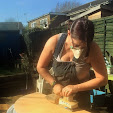Sometimes we are called upon to design things that we know just shouldn't be designed. Sometimes the client simply won't take no for an answer. Sometimes you want to throw the book at them... or at least lend it to them.
Increasingly, we need less design and more substance. Instead of an expensive elearning course, there are times when a free wiki containing a series of user generated screen capture videos is enough. There are times when we need a YouTube channel more than we need an LMS.
All of these thoughts came thumping home to me recently, when I picked up a few packs of microwave pizzas (as you do, when you have hulking great teenage boys in the house) and saw that they have a special offer give-away thing for a knork.
Now maybe you already know what that is. Heck, maybe you have a whole set of silver plated knorks in your cutlery drawer. But - pardon my ignorance - I had never heard of them before. I had heard of a spork: a hybrid of spoon and fork. I have even used one from time to time, since a few takeaway places issue them with their meals. To be honest, most of the time, I have thought a spoon would do, but the spork has been innocuous enough.
But a knork...? A hybrid of knife and fork...? What the...?
Let's think about this.
I know that cutlery usage can be a little different in the US, but in the UK, we use a knife and a fork simultaneously. One in each hand. The fork holds the food still, while the knife is used to cut it. How do you achieve that with a knork? How do you hold the food still and then cut it when you have only one utensil?
Then there is the little matter of sticking the knork into your mouth. If it has the characteristics of a knife, I presume this thing has a blade on it. In fact, if it caters to both lefties and righties, maybe it has two blades! Now I reckon Pippi Longstocking is right when she says that grownups are superstitious and think it's 'bad luck' to stick a knife into your mouth. I think it could be extremely bad luck indeed. On the other hand, if the blade isn't sharp enough to do you any harm, then I can't see it enjoying much success in the cutting stakes (or even steaks) either.
And so here we have a utensil that is both impractical and potentially harmful. It looks to me as if someone designed it because it could be done, without giving any thought to whether it should be done.
So, yes. We can design a whole series of 20 minute elearning tunnels and stick them into an LMS. We can make it all trackable so that, at any given moment, you can see who has used which materials. But should we?
Will they really add value to your organisation's learning experience? Will they improve performance? Or will they join the list of a long line of expensive things that seemed like a good idea at the time? Could something else do the job better? Maybe an elgg space will suit your purposes just as well. Maybe the solution already exists somewhere in someone's personal job aids, and is just waiting to be shared with the rest of the team.
So before you go out and spend a fortune designing and developing a knork, just check your cutlery drawer to see whether you haven't already got something that can do the trick.
Friday, May 07, 2010
Just because you can doesn't mean you should
Posted by
The upsycho
at
6:15 pm
![]()
Labels: Design, Learning Design
Subscribe to:
Post Comments (Atom)


No comments:
Post a Comment